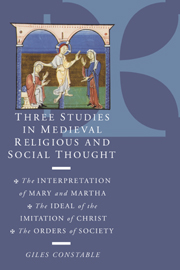 Three Studies in Medieval Religious and Social Thought
Three Studies in Medieval Religious and Social Thought Book contents
- Frontmatter
- Contents
- List of illustrations
- Preface
- List of abbreviations
- I THE INTERPRETATION OF MARY AND MARTHA
- II THE IDEAL OF THE IMITATION OF CHRIST
- The imitation of the divinity of Christ
- The imitation of the humanity of Christ
- The imitation of the body of Christ
- The late Middle Ages
- III THE ORDERS OF SOCIETY
- Bibliography of secondary works
- Index of manuscripts
- Biblical index
- General index
The imitation of the humanity of Christ
Published online by Cambridge University Press: 08 December 2009
- Frontmatter
- Contents
- List of illustrations
- Preface
- List of abbreviations
- I THE INTERPRETATION OF MARY AND MARTHA
- II THE IDEAL OF THE IMITATION OF CHRIST
- The imitation of the divinity of Christ
- The imitation of the humanity of Christ
- The imitation of the body of Christ
- The late Middle Ages
- III THE ORDERS OF SOCIETY
- Bibliography of secondary works
- Index of manuscripts
- Biblical index
- General index
Summary
while the doctrine of the divinization of man was associated with the divine nature of Christ, His human nature and earthly role served as a model for a perfect life on earth. These two types of imitation drew on different religious and philosophical traditions, and the contrast between them can be seen in terms of doing and being, present and future, or (more prejudicially) matter and spirit. It can also be seen as a difference in the concepts of obeying, following, and imitating. The shift in the eleventh and twelfth centuries from concentrating on Christ's divinity to following His humanity thus reflected a new interest in the behaviour of man, which contributed to the emergence of a more ethical character in Christianity.
In spite of these differences the two views depended to a great extent on the same biblical texts and used the same language, and they are impossible to distinguish strictly. It is not therefore surprising that some of the same writers, and a few even of the same passages from their works, are cited in this chapter as well as the first. Texts can be found from throughout the Middle Ages to support almost any interpretation of the imitation of Christ, and the eleventh and twelfth centuries saw a change in emphasis and concern rather than the replacement of one ideal by another. As the Middle Ages progressed the term imitatio Christi, like vita apostolica and paupertas, took on new meanings without entirely losing its old ones, and it would be impossible to say exactly when it lost one meaning and assumed another.
- Type
- Chapter
- Information
- Three Studies in Medieval Religious and Social ThoughtThe Interpretation of Mary and Martha, the Ideal of the Imitation of Christ, the Orders of Society, pp. 169 - 193Publisher: Cambridge University PressPrint publication year: 1995
- 1
- Cited by


